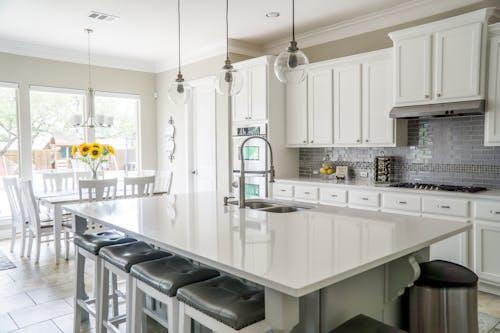A good kitchen layout does more than look nice. It supports how you cook, clean, host, and relax. The choice often comes down to open concept or semi-closed. Both work when planned well. The right pick depends on your rooms, your habits, and your climate.
Daily use and flow
Open plans keep movement simple. You can cook, watch kids, and talk with guests in one space. Noise and smells travel more, so ventilation matters. Semi-closed plans create short routes with visual calm. Doors or framed openings hide mess while meals come together. Add a simple pathway map before you draw cabinets. Mark where people pause, then keep those zones clear.
Light, windows, and sightlines
Open kitchens get daylight from nearby rooms. This can brighten dark winters and lift the mood. Semi-closed kitchens stay airy with wider cased openings and glass doors. Map the sun, then place prep and seating areas where light is best at the times you use them.
For a room-by-room checklist, see this kitchen design guide. Use matte counters near windows to cut glare. Add dimmers so breakfast and late-night cleanup stay comfortable. Keep switches simple so anyone can set the light fast.
Heat, noise, and ventilation
Open spaces spread heat evenly from cooking and windows. They also spread sound from blenders and movies. Plan zones to control both. A semi-closed layout creates pockets that are easier to heat and are quieter. Match each plan with real ventilation. Use adequate CFM, quiet fans, and make-up air where required. Closeable doors help when you need silence. Soft finishes help too; add rugs, lined curtains, and felt pads to tame echo.
Storage and visual order
Open plans keep everything on display. This pushes you to tidy up, but it also exposes clutter. Consider taller pantries, appliance garages, and closed upper cabinets. Semi-closed rooms carry storage on more walls, which means easier spots for full-height pantries and utility nooks.
Hide small appliances where you use them, not across the house. You should also label zones by task so other family members can find things without asking. Use drawers for heavy items and keep daily dishes at shoulder height.
Furniture, islands, and traffic
Open kitchens often rely on a strong island to anchor the room. Size it for seating, prep area, and outlets. Keep clearances consistent so traffic stays smooth. Make sure to check sightlines and avoid pinch points. A well-placed island keeps tools close and mess controlled.
Semi-closed layouts may split tasks between two runs or a peninsula. This shortens steps and separates cooking from hanging out. Plan where the stools will be positioned so that doors and drawers still open. Keep aisle widths consistent around the range, sink, and fridge. You should also add task lights over chopping zones, not only over the island.
Budget, phasing, and resale
Open plans can cost more if you remove walls or add beams. They can also save if you simplify finishes across one big room. Semi-closed plans work well for phased upgrades. You can refresh one room without touching the rest.
In resale terms, both plans sell when they match the house. Buyers want light, storage, and a logical flow. Document your choices with a simple mood board and layout sketch. This helps contractors price accurately and keeps bids comparable.
Endnote
There is no universal winner. Open concept shines for connection, light, and flexible hosting. Semi-closed wins for storage, focus, and easy control of noise and heat. Start with your daily routine and the rooms you already have. Then shape the layout to support how you live, season after season.

